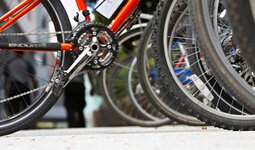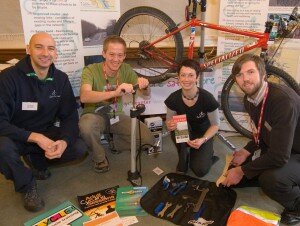Design Checklist & Guidance
 The checklist below includes links to current guidance and best practice for a comprehensive range of design issues. It is also available as a pdf document where a hard copy is required.
The checklist below includes links to current guidance and best practice for a comprehensive range of design issues. It is also available as a pdf document where a hard copy is required.
Introduction
The purpose of this document is:
- to provide short cuts to the most up to date guidance and best practice
- printed out as a pdf document, to serve as a simple checklist to help planners and designers ensure that their projects create cycle friendly infrastructure.
Clicking on the links below will take you to concise guidance and examples, with further links to the web-available technical documents on which the advice is based. Where web-based information is not available full details of references are included.
If you would like to make suggestions for improvements or contribute experience or illustrations, these would be welcomed and should be sent to .
In addition to this Design Checklist, Cycling England’s Smart Measures Portfolio deals with initiatives that combine incentives, information, training and promotion, and are closely tailored to the needs of a specific target market.
A. On-Carriageway solutons
(to be in accordance with hierarchies of provision and 5 core principles)
A.01 Invisible Infrastructure: Cycle-specific infrastructure should not be introduced without first establishing whether cyclist needs would be better met through demand management or traffic management measures that reduce both the volume and speed of motor traffic.
A.02 Speed Reduction: Reducing traffic speeds can help to reduce or eliminate the need for special facilities for cyclists as well as contributing to casualty reduction and the creation of a more ‘people friendly’ environment.
A.03 Traffic Calming: All traffic calming schemes should be audited to ensure that they meet cyclists needs.
A.04 Clear Space: Carriageway profiles (including those at pinch points created by build-outs and refuges) should be chosen to create adequate space for cyclists to be passed by other roads users in safety and comfort.
A.05 Exemptions to Traffic Regulation Orders (TROs): Cyclists should be exempt from restrictions within all TROs, including banned turns and road closures, unless there are proven safety reasons for not doing so.
A.06 Contra-flow Cycling: Two-way cycling should be the default option where it is proposed to introduce one-way working for general traffic.
A.07 Vehicle Restricted (Pedestrianised) Areas (Town Centre Access): Allowing cycling through restricted areas should be the rule rather than the exception. Where this is not appropriate, consideration should be given to allowing access to cyclists outside of the busiest pedestrian hours.
A.08 Signal Controlled Junctions: Cyclists’ needs should be considered as part of the design of all signalised junctions and, whenever possible, provided with an advantage over motorists.
A.09 Advance Stop Lines (ASLs): ASLs should be considered at all signal controlled junctions. The depth of the reservoir should be designed to take account of all of the manoeuvres cyclists need to make when entering and leaving the ASL as well as the numbers of cyclists.
A.10 Bus Lanes and Bus Stops: All bus lanes, including contraflow lanes, should be open to cyclists by default. Cyclists should only be prohibited from using them if it can be proven that it would be unsafe or not practicable to achieve this. New bus stops should be audited to ensure that they do not compromise cyclists’ needs or safety.
A.11 Cycle Lanes: The decision to provide cycle lanes should be reached by reference to the hierarchy of provision and such tools as the CROW derived ’speed/flow’ diagram; they should not be seen as a universal solution.
Where provided, cycle lanes should be a minimum of 1.5m wide, continuous, made conspicuous across side roads at junctions and not abandon cyclists where roads become narrow, for example at right turning lanes.
Where cycle lanes are being introduced, the cost of remedial measures to the carriageway surface should be included within the scheme budget.
A.12 Removal of Road Centrelines: Consideration should be given to the removal of centrelines as an option where carriageway widths do not permit the introduction of cycle lanes of adequate width (min 1.5m) whilst retaining two general traffic lanes.
A.13 Roundabouts: The use of continental-style design should be considered where roundabouts are to be introduced on cycle routes with entry flows of up to 2500 vehicles per hour.
A.14 Corner Radii: The minimum radius of curvature for the path followed by cyclists using the road should be 6m. Where cyclists need to turn sharply (e.g. when leaving the carriageway at a cycle gap) this may be reduced to 4m.
A.15 Audits and Risk Assessment: All changes to the highway network, including maintenance schemes, should be the subject of a cycle audit. Were safety audits identify that normally recognised design standards cannot be met, projects should be the subject of a risk assessment that involves user representatives.
B. Off-Carriageway Solutions
(to be in accordance with hierarchies of provision and 5 core principles)
B.01 Connections and Links: Additional off-carriageway links can offer enhanced permeability, potentially safer routes for cyclists and advantageous journey times compared to motor traffic. These need to be designed, built and maintained so that they achieve their intention of drawing cyclists away from less attractive routes on the carriageway.
The measures available to create cycle links can range from a cycle gap in a road closure to the construction of a new bridge. To be effective, cycle links should be clearly signed, direct and relevant to cyclists’ needs.
Off-carriageway links need to be designed, built and maintained so that they achieve their intention of drawing cyclists away from less attractive routes on the carriageway.
B.02 Road Crossings – Side Roads: Maintaining the continuity of cycle tracks is important if they are to provide an attractive alternative to being on road. Consideration should be given to the use of cycle priority crossings where they cross minor roads where daily traffic flows are below 2000 vehicles per day.
European experience suggests that where the cycle track is used solely by cyclists travelling in the same direction as vehicles on the adjacent traffic lane, returning cyclists to the carriageway before side road junctions can also be an effective solution.
B.03 Road Crossings – Mid-link: Cycle tracks may be provided with priority crossings of roads where speeds are less than 30 mph, total traffic flows do not exceed 4,000 vehicles per day and the crossing is sited on a flat-topped road hump.
A number of mainland European countries allow the use of zebra-style pedestrian crossings by cyclists. At present it is not unlawful for cyclists to cycle across zebra crossings within the UK. However, since there is no legal requirement for motorists to give way when they do, encouraging this practice may increase hazards for cyclists. Where cycle tracks naturally bring cyclists to such facilities, wider than normal crossings should be provided and ‘Cyclists dismount’ signs used.
B.04 Junction and Forward Visibility: Adequate visibility (20m where the design speed is 12mph) should be provided or measures to manage speed considered (see also B.08 Access and Speed Controls).
B.05 Footway Crossings and Tactile Paving: Where cycle tracks cross footways to reach the carriageway, blind and partially sighted pedestrians should be warned by means of corduroy paving. Ladder tactile paving should not be placed in the path of a turning cyclist. The length of ladder paving should be kept to a minimum (800mm) wherever possible. (see also B.06 Flush Kerbs and B.07 Cycle Track Junctions)
B.06 Flush Kerbs: FLUSH kerbs, i.e. with no upstand between abutting surfaces, should be provided at all transition points, with channel blocks and increased drainage provision used if necessary. Flush kerbs at crossings should be wide enough to allow cyclists to turn on/off the carriageway without the need to pull out into the path of vehicles going in the same direction.
B.07 Cycle Track Junctions: Adequate corner radii should be provided at junctions between cycle tracks (minimum 2m) and chamfered corners (min 1m) at the rear of footways crossed by cycle tracks, not 900 tie-ins.
B.08 Access and Speed Controls: There should be a presumption against the use of any access barriers on a cycle track/shared-use path until/unless there is a proven need because of the difficulties they can cause all users. Where it is necessary to reduce the speed of cyclists, two rows of staggered bollards are preferred.
B.09 Obstruction of cycle track accesses: Where cycle tracks emerge onto the carriageway, suitable arrangements should be put in place to prevent parked vehicles obstructing access and to ensure adequate visibility (e.g. ‘Keep Clear’ road markings, double yellow lines etc.)
B.10 Wheeling Channels: Stepped footbridges encountered along cycle routes should be fitted with suitable wheeling ramps.
C. Miscellaneous
C.01 Headroom: Headroom in new subways should be a minimum of 2.4m. Existing subways with lower headroom have been successfully converted to cycle use but should be risk assessed and warning signs added where appropriate (see also A.15 Audits and Risk Assessment). Signs should be mounted at least 2.3m above the surface of a cycle track.
Surfaces should be chosen with due regard to whole-life costs (off-carriageway as well as on). Materials should always be machine laid to ensure a smooth running surface.
C.02 Surfaces:For aesthetic, environmental and cost reasons coloured surfaces should only be used at potential hazards and conflict points, or where encroachment by motor vehicles is a problem Any decision to use coloured surfacing for all cycle facilities will need to balance the potential safety benefits against the future maintenance commitment that will be required.
C.03 Signs: The use of ‘Cyclists dismount’ and ‘End of route’ signs should always be avoided unless there is a proven need.
The use of advance directions signs, particularly map-type where this will direct cyclists through complex junctions, can help cyclists conserve energy lost when stopping to read signs erected at junctions.
Posts and sign faces should not reduce the effective width of a cycle track by being placed in the path of pedestrians or cyclists. Where possible, sign posts and lamp columns should be set back 500mm beyond the edge of a cycle track. Where walls or fences prevent this they should be placed tight up against them.
Where vandalism is a problem signs should be mounted high enough to discourage graffiti and square posts used to prevent rotation.
Sign x-heights should reflect the positioning and likely speed of approaching cyclists.
C.04 Cycle parking: The inclusion of ‘Sheffield’ type cycle parking stands should be considered in all highway traffic management and maintenance schemes.
C.05 Monitoring: Local authorities should develop a robust system for monitoring and evaluating cycling activities throughout their area to enable targets to be set for future growth.
Cycle flows should be measured before and after the introduction of all new cycle tracks and lanes and consideration given to developing local targets based on these surveys that can feed into overall cycle–use targets.
Provision for the installation of automatic counters should be included in cycling scheme budgets (including those secured through Section 278 and Section 106 agreements in new-build schemes) to enable a network of data collection points to be established.
C.06 Maintenance: All new cycle infrastructure should be delivered in a manner that will minimise whole-life costs. Maintenance programmes should reflect the importance of cycling as a mode of transport that is to be encouraged and authorities should ensure that non-highway sections of cycle networks are the subject of an adequately funded maintenance regime.
Highway authorities should consider using highway maintenance funding for all projects created to deliver their LTP and other objectives. On-road, attention should be focused on the condition of the strip of carriageway within 1.5 – 2m of the kerb. Off-road, both construction and landscaping should aim to minimise maintenance costs.
C.07 Integrating Cycling into Development Proposals: All new developments should be accessible by bicycle. Their highway infrastructure should focus on on-road provision for cyclists with roads designed to deliver low speeds whilst at the same time creating permeability and advantage through the use of connections and links not available to motor traffic.
New developments should also provide for, and fund, links to the wider cycle network including quality cycle routes to such destinations as town centres, schools, employment sites, transport interchanges etc; i.e. works remote from the site.
C.08 Drainage: The need for adequate drainage should be considered during the design of all cycle tracks, especially at tie-ins, to prevent ponding or erosion during periods of heavy rain. Cycle-friendly gully grates should always be used and care taken to ensure that gullies are not located within the path of cyclists.
C.09 Gradients: Cycle tracks should have a maximum gradient of 3% with the absolute maximum 5% for lengths up to 100m. On the approach to priority junctions this should not exceed 3%. Where steeper slopes are unavoidable the limiting gradient is 7% for lengths up to 30m.
C.10 Lighting: Off-road routes which cyclists are encouraged to use after dark should be lit. Note: Even lit facilities remote from passive surveillance are unlikely to be used and a lit on-road alternative should be identified.
Consider the provision of floodlighting where cycle routes cross roads.
C.11 Cyclists and Junctions: All junction designs should seek to give priority to cyclists where practicable, and minimise delay and maximise cyclists’ safety and comfort in all cases (see also A.08 Signal Controlled Junctions and A.13 Roundabouts).



